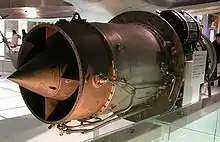Ishikawajima-Harima J3
The Ishikawajima-Harima J3 was a Japanese turbojet aircraft engine. It was the first jet engine designed and built in Japan after the Second World War and was used to power the Fuji T-1 trainer and as a booster engine in the Kawasaki P-2J patrol aircraft.
| J3 | |
|---|---|
 | |
| Type | Turbojet |
| National origin | Japan |
| Manufacturer | Ishikawajima-Harima |
| Major applications | Fuji T-1 Kawasaki P-2J |
Design and development
Development of the J3, the first Japanese post-war jet engine,[1] intended to power the Fuji T-1 jet trainer, was begun in 1955 by the Nippon Jet-Engine Company, with Ishikawajima-Harima Heavy Industries (IHI) being designated prime contractor in 1959.[2][3] The resulting engine was a small, simple axial-flow turbojet.
The first pre-production engine began flight testing in a Curtiss C-46 testbed in February 1960, with production deliveries beginning in April 1962.[4]
Operational history
While the J3 was designed to power the Fuji T-1, it was not ready in time and the first version of the T-1 was powered by imported British Bristol Orpheus engine. The J3-IHI-3 version of the engine equipped the later T-1B version.[4] A more powerful version of the J3, the J3-IHI-7 was used to re-engine the T-1Bs and as booster engines for the Kawasaki P-2J maritime patrol aircraft.[5]
Variants

- J3-1
- Nippon Jet-Engine Company prototype.[3][6]
- J3-IHI-3
- Initial production version for Fuji T-1B trainer. 11.8 kN (2,645 lbf) thrust.[4]
- J3-IHI-7
- More powerful version used as auxiliary engine in the P-2J and to re-engine T-1B trainers. 13.7 kN (3,080 lbf) thrust.[5]
- J3-IHI-7C
- 13.7 kN (3,080 lbf) for take-off.
- J3-IHI-8
- 15.19 kN (3,415 lbf) for take-off.
- J3-IHI-F
- Aft-fan variant, 16.7 kN (3,750 lbf).[4] — the later Ishikawajima-Harima F3 turbofan engine began flights in 1985.[7][8]
Applications
Specifications (J3-IHI-7C)
Data from Jane's All The World's Aircraft 1976–77[5]
General characteristics
- Type: axial flow turbojet
- Length: 1,661 mm (65.4 in) (without tailpipe)
- Diameter: 627 mm (24.7 in)
- Dry weight: 430 kg (948 lb) (with accessories)
Components
- Compressor: eight-stage axial compressor
- Combustors: annular combustion chamber with 30 fuel supply pipes and vapouriser tubes
- Turbine: single-stage axial-flow
- Fuel type: JP-4 jet fuel
Performance
- Maximum thrust: 13.7 kN (3,080 lbf) (take-off power)
- Overall pressure ratio: 4.5:1
- Air mass flow: 25.4 kg/s (56 lb/s)
- Specific fuel consumption: 106.9 kg/kN hr (1.05 lb/lbf hr)
- Thrust-to-weight ratio: 3.2
References
- Flight International 9 October 1976, p. 1150.
- Flight International 28 June 1962, p. 1012.
- Taylor 1966, p. 492.
- Taylor 1966, pp. 492–493.
- Taylor 1976, pp.735–736.
- Bridgman, Leonard, ed. (1959). Jane's all the World's Aircraft 1959–60. London: Sampson Low, Marston & Co. Ltd. p. 512.
- Hamada, T., Akagi, M., Toda, D., Shimazaki, H., & Ohmomo, M. (1989). T-4 Inlet/Engine Compatibility Flight Test Results. Presented at the AIAA/ASME/SAE/ASEE 25th Joint Propulsion Conference, Monterey, CA: American Institute of Aeronautics and Astronautics.
- Wilkinson, Paul H. (1964). Aircraft engines of the World 1964/65 (20th ed.). London: Sir Isaac Pitman & Sons Ltd. p. 192.
Further reading
| Wikimedia Commons has media related to Ishikawajima-Harima J3. |
- Taylor, John W.R., ed. (1966). Jane's All the World's Aircraft 1966–67. London: Sampson Low, Marston & Co. Ltd.
- Taylor, John W.R., ed. (1976). Jane's All the World's Aircraft 1976–77 (67th ed.). London: Jane's Yearbooks. ISBN 0-3540-0538-3.